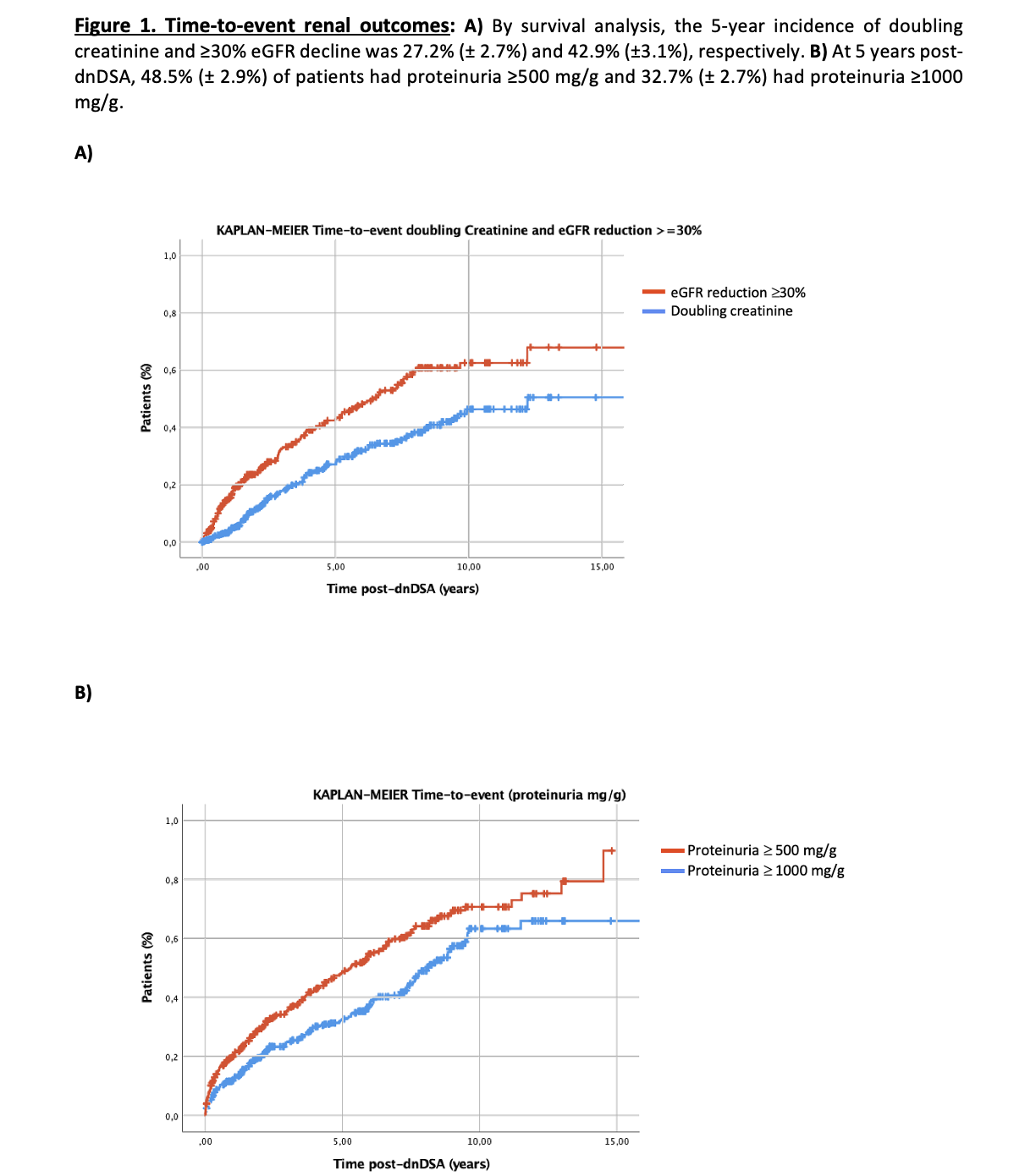Clinical Evolution of Patients with De Novo DSA After Kidney Transplantation
1Nephrology department-IDIVAL, Hospital Universitario Marqués de Valdecilla, Santander, Spain, 2Institute for Transfusion Medicine, HLA-Laboratory, Charité - Universitätsmedizin, Berlin, Germany, 3Department of Nephrology and Medical Intensive Care, Charité - Universitätsmedizin, Berlin, Germany
Meeting: 2022 American Transplant Congress
Abstract number: 116
Keywords: Antibodies, Graft failure, Kidney transplantation, Proteinuria
Topic: Clinical Science » Kidney » 47 - Kidney Complications: Immune Mediated Late Graft Failure
Session Information
Session Name: Kidney Complications: Chronic Antibody Mediated Rejection & Immune Mediated Late Graft Failure
Session Type: Rapid Fire Oral Abstract
Date: Sunday, June 5, 2022
Session Time: 5:30pm-7:00pm
 Presentation Time: 6:00pm-6:10pm
Presentation Time: 6:00pm-6:10pm
Location: Hynes Room 302
*Purpose: De novo donor-specific antibodies(dnDSA) are related to antibody-mediated rejection(ABMR), but the evolution of patients after dnDSA is variable and not always ABMR and graft dysfunction occur. Regular laboratory values can predict graft function and should be considered as reliable endpoints. We performed this study to assess the situation of the patients after dnDSA and address potential predictors of graft failure.
*Methods: A retrospective analysis including 400 kidney transplant recipients with dnDSA against the last graft until 31/05/2021 was performed. Laboratory values at dnDSA first occurrence were collected, and the dates of doubling creatinine, ≥30% eGFR decline, proteinuria ≥500 and ≥1000 mg/g in at least two consecutive determinations and before graft failure were registered from dnDSA occurrence. Patients were classified as ‘completely stable’ (no graft loss, no ≥30% reduction in eGFR, no proteinuria ≥500 mg/g) at 5 years post-dnDSA.
*Results: The median follow-up period was 9.7 years (7.2-12.2). At dnDSA first occurrence, the median value of proteinuria was 182.0 mg/g, eGFR 41.0 ml/min and creatinine 1.6 mg/dl. Creatinine doubled after a median of 2.8 years (1.5-5.0), and the time from doubling creatinine to graft failure was 1.0 years (0.4-2.9). Analyzing a ≥30% decline in eGFR, the time from first occurrence of dnDSA to this event was 2.0 years (0.6-4.2), with a median of 2.0 years (0.8-3.2) to graft loss. The median time from proteinuria ≥500mg/g and ≥1000mg/g to graft failure was identical (1.8 years). The 5-year incidence of renal outcomes is shown in figure 1. At 5 years post-dnDSA, 115 of patients were ‘completely stable’.
*Conclusions: A relevant (28.7%) proportion of patients has a ‘completely stable’ clinical course after 5 years post-dnDSA. Proteinuria is a marker of progression in our patients. Doubling creatinine is a predictor of graft dysfunction as can also be a ≥30% decline in eGFR, appearing earlier after dnDSA.
To cite this abstract in AMA style:
Moral CLópezdel, Lachmann N, Hergovits S, Stauch D, Akifova A, Naik M, Osmanodja B, Schmidt D, Budde K. Clinical Evolution of Patients with De Novo DSA After Kidney Transplantation [abstract]. Am J Transplant. 2022; 22 (suppl 3). https://atcmeetingabstracts.com/abstract/clinical-evolution-of-patients-with-de-novo-dsa-after-kidney-transplantation/. Accessed December 29, 2025.« Back to 2022 American Transplant Congress

